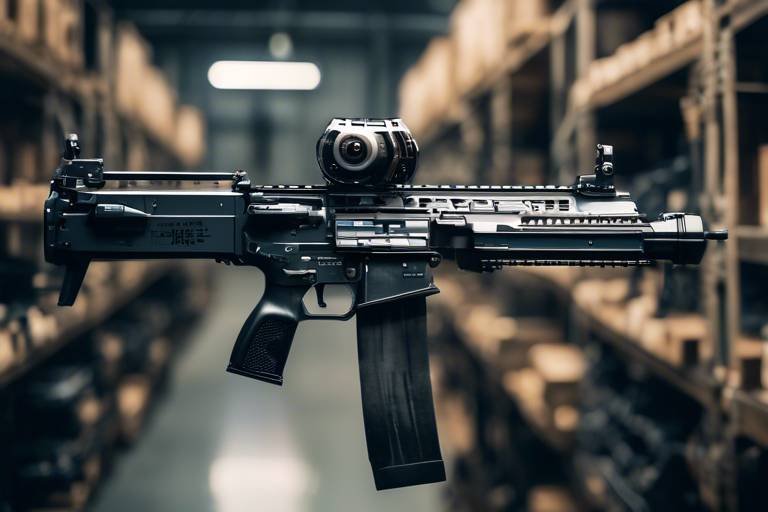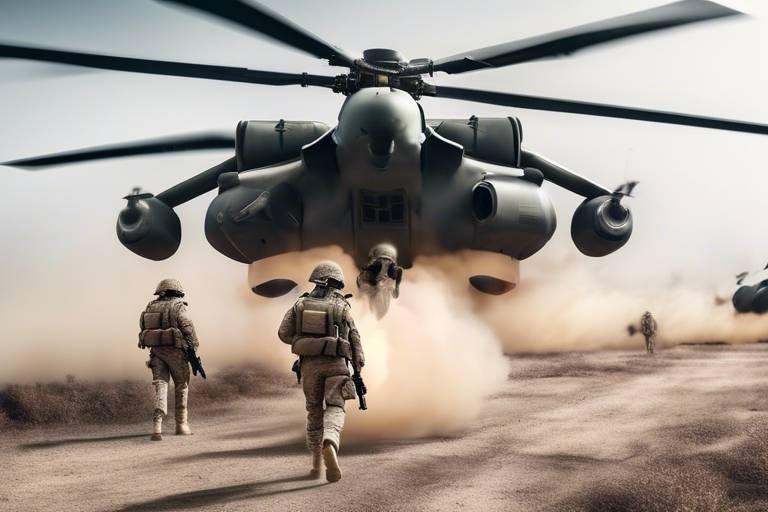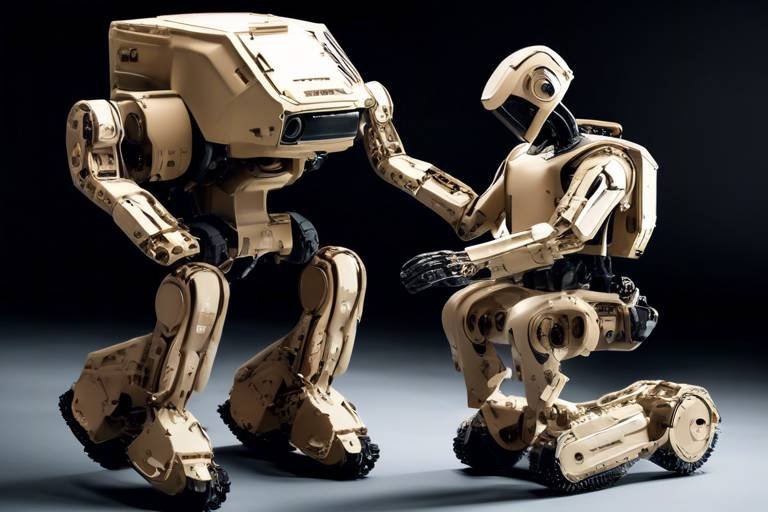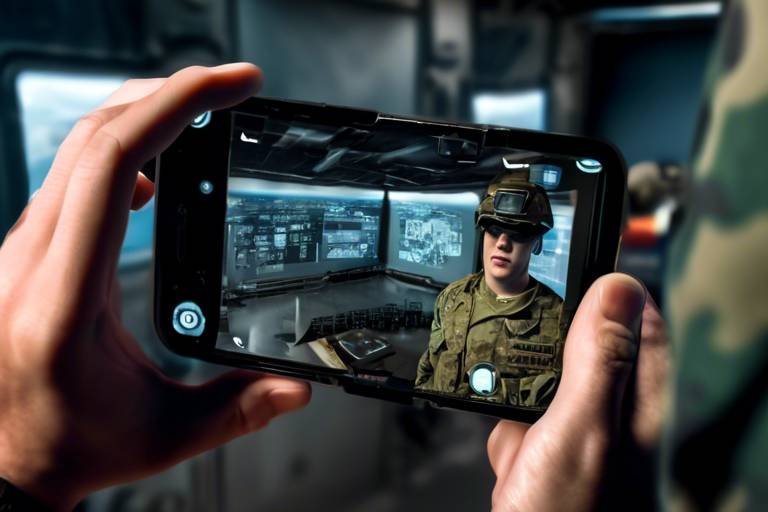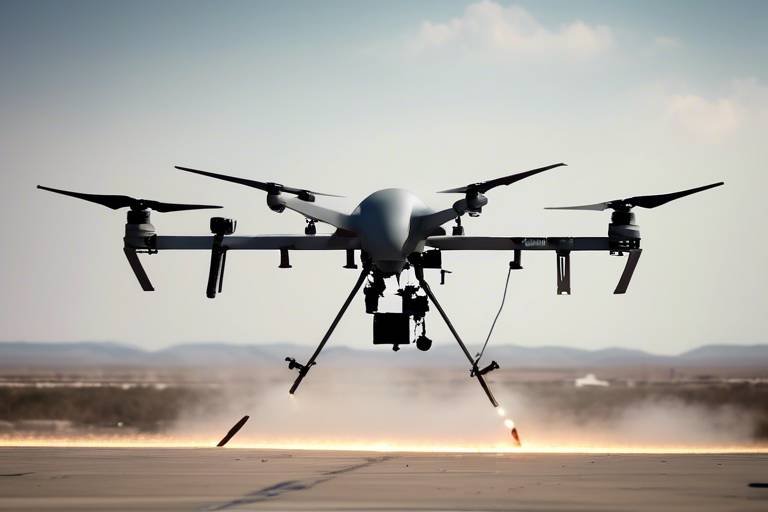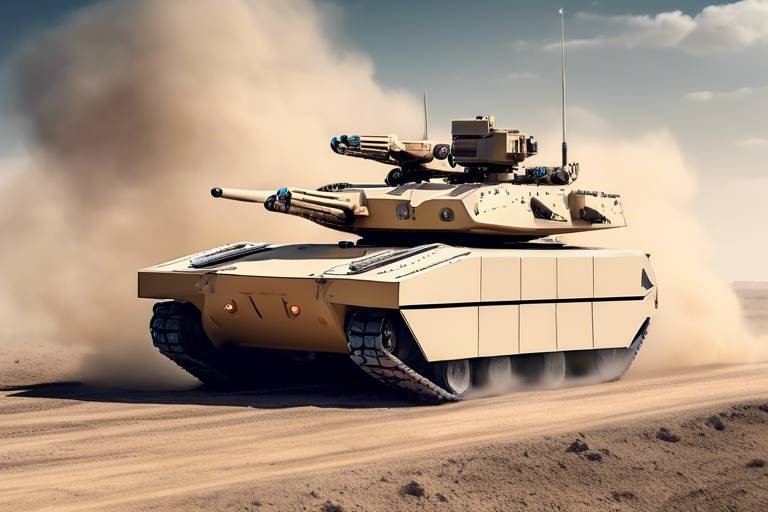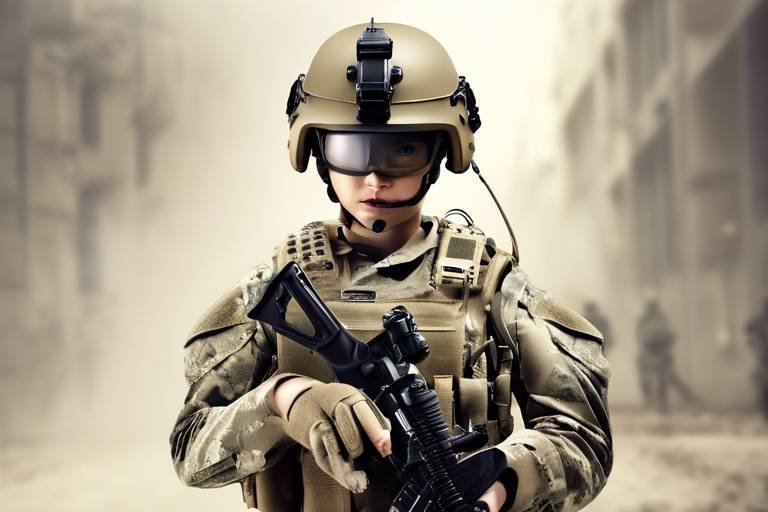How AI is Impacting Weapon Design and Production
Artificial Intelligence (AI) is not just a buzzword; it's a game-changer in many industries, and the military sector is no exception. The integration of AI into weapon design and production is reshaping how we think about warfare and defense technologies. Imagine a world where weapons are designed not just with human intuition but with the analytical power of AI, leading to innovations that were once considered the stuff of science fiction. This article delves into the transformative role of AI in weapon systems, highlighting how it enhances design, streamlines production, and raises ethical questions.
Artificial intelligence is revolutionizing weapon design by enabling rapid prototyping and advanced simulations. This means that designers can create and test new weapon systems in virtual environments before they ever hit the production line. Think of it as a video game where developers can tweak every aspect of a character before launching it into the market. The outcome? More effective and efficient weapon systems that meet the demanding needs of modern warfare.
For instance, AI algorithms can analyze vast amounts of data to identify the most effective designs for specific combat scenarios. This not only speeds up the design process but also ensures that the final product is optimized for performance. The traditional trial-and-error method is being replaced with data-driven insights, making weapon systems more reliable and effective.
When it comes to manufacturing, the integration of AI enhances precision and reduces costs significantly. Imagine a production line where machines communicate with each other, adjusting their operations in real-time based on the latest data. This level of automation streamlines production lines for weapons, ensuring timely delivery to military operations. AI can manage everything from inventory levels to production schedules, which minimizes human error and maximizes efficiency.
Quality control is paramount in weapon production, and AI technologies are stepping up to the plate. By utilizing machine learning algorithms, manufacturers can detect defects and ensure compliance with rigorous military standards throughout the production cycle. This isn't just about making sure a weapon works; it's about ensuring that it functions perfectly under the most extreme conditions.
Another fascinating aspect of AI in weapon systems is predictive maintenance. This technology helps identify potential equipment failures before they occur, minimizing downtime and ensuring that weapon systems remain operational and ready for deployment. It's like having a crystal ball that tells you when your car might break down, allowing you to fix it before it leaves you stranded.
AI also plays a crucial role in optimizing supply chain logistics. Effective inventory management and resource allocation are vital for maintaining operational readiness in military contexts. By analyzing trends and predicting future needs, AI can help military strategists ensure that the right resources are in the right place at the right time.
In the heat of battle, decisions need to be made quickly and accurately. AI facilitates data analysis, enabling military strategists to make informed decisions regarding weapon deployment and usage based on real-time battlefield data. This capability can mean the difference between success and failure in critical situations.
While the advancements brought by AI are impressive, they don't come without a host of ethical implications. The use of AI in weaponry raises serious concerns about accountability for autonomous systems and the potential for unintended consequences in combat scenarios. Who is responsible if an autonomous weapon makes a mistake? These are questions that society must grapple with as we navigate this new frontier.
The development of autonomous weapons systems challenges existing legal frameworks, necessitating discussions on accountability and the moral implications of machines making life-and-death decisions. Are we ready to trust algorithms to make such critical choices? The implications of this technology are profound and require careful consideration.
Public perception plays a critical role in shaping policies surrounding AI in warfare. As societal concerns about the implications of these technologies grow, they influence governmental regulations and military strategies. It's essential for policymakers to stay ahead of public sentiment to ensure that the deployment of AI in military contexts aligns with ethical standards and societal values.
- What is AI's role in weapon design? AI enables rapid prototyping and advanced simulations, allowing for more effective weapon systems.
- How does AI improve production processes? AI enhances precision, reduces costs, and streamlines production lines for timely delivery.
- What ethical concerns arise from AI in warfare? Concerns include accountability for autonomous systems and the potential for unintended consequences in combat.
- How can AI aid in decision-making during combat? AI facilitates data analysis, allowing for informed decisions based on real-time battlefield data.

AI-Driven Design Innovations
Artificial intelligence is not just a buzzword; it’s a game changer in the realm of weapon design. Imagine a world where weapons are designed not just by humans, but with the help of machines that can analyze vast amounts of data in seconds. This is precisely what AI brings to the table. By utilizing rapid prototyping and advanced simulations, AI enables engineers to create and test weapon systems at an unprecedented pace. This means that military forces can adapt to the ever-evolving landscape of modern warfare more efficiently than ever before.
One of the most fascinating aspects of AI-driven design is its ability to predict outcomes based on historical data. For instance, algorithms can analyze past battlefield engagements and identify which weapon designs performed best under specific conditions. This not only leads to the creation of more effective weapon systems but also ensures that these systems are tailored to meet the unique demands of contemporary combat scenarios. It's like having a crystal ball that allows designers to foresee the future of warfare and prepare accordingly.
Moreover, AI facilitates collaborative design processes that bring together experts from various fields. Engineers, military strategists, and data scientists can work in unison, leveraging AI tools to brainstorm and iterate on designs that would have previously taken months or even years to develop. This collaborative approach not only speeds up the design process but also enhances creativity, resulting in innovative solutions that might not have emerged in a traditional setting.
In addition to speed and collaboration, AI also contributes to the optimization of materials used in weapon design. By analyzing the properties and performance of different materials, AI can recommend the best options for specific applications. This leads to the creation of lighter, stronger, and more durable weapons that are crucial for maintaining an edge in combat. Think of it as having a personal assistant that knows exactly what you need and can find it faster than you ever could.
However, the advancements brought about by AI in weapon design are not without challenges. As we embrace these technologies, we must also consider the implications of relying on machines for such critical tasks. The balance between human intuition and machine efficiency is delicate, and as we move forward, it will be essential to ensure that ethical considerations are woven into the fabric of AI-driven design innovations.
In summary, AI is not just enhancing weapon design; it is revolutionizing it. From rapid prototyping to collaborative efforts and material optimization, the integration of artificial intelligence in weapon design is paving the way for more effective and efficient military technologies. As we continue to explore these innovations, one thing is clear: the future of warfare will be shaped by the intelligent interplay of human creativity and machine learning.
- How does AI improve weapon design? AI enhances weapon design through rapid prototyping, advanced simulations, and data analysis, allowing for quicker and more effective design iterations.
- What are the risks associated with AI in weapon design? The primary risks include over-reliance on algorithms, potential ethical dilemmas, and the challenge of ensuring accountability in autonomous systems.
- Can AI predict the effectiveness of weapon systems? Yes, AI can analyze historical data to predict how different weapon designs might perform in various combat scenarios.
- What role does collaboration play in AI-driven weapon design? Collaboration among experts from different fields is enhanced by AI tools, leading to innovative designs that leverage diverse expertise.

Automation in Production Processes
In today's fast-paced world, the integration of artificial intelligence (AI) into weapon production processes is nothing short of revolutionary. Imagine a factory floor where machines communicate seamlessly, adjusting their operations in real-time to enhance efficiency and precision. This is not just a futuristic dream; it’s happening right now. The automation of production processes is streamlining the way weapons are manufactured, ensuring that they are not only produced faster but also with a level of accuracy that was previously unimaginable.
One of the most significant advantages of AI in weapon production is its ability to enhance precision. Traditional manufacturing methods often involve human error, which can lead to defects and inconsistencies. However, with AI-driven automation, machines can operate with pinpoint accuracy, reducing the margin for error. For instance, AI algorithms can analyze the production process and make real-time adjustments to machinery, ensuring that every component meets strict military standards.
Furthermore, the cost-effectiveness of AI automation cannot be overstated. By automating repetitive tasks, manufacturers can significantly reduce labor costs and minimize waste. This not only leads to a more efficient production line but also allows for the reallocation of resources to research and development, fostering innovation in weapon design. The table below illustrates the potential cost savings associated with AI automation in weapon production:
| Aspect | Traditional Production | AI-Driven Production |
|---|---|---|
| Labor Costs | High | Reduced |
| Production Speed | Moderate | High |
| Waste Generation | Significant | Minimal |
| Quality Consistency | Variable | High |
Additionally, AI automation plays a crucial role in maintaining the timeliness of weapon production. In military contexts, the demand for rapid deployment can be critical. AI systems can predict production timelines and optimize workflow to ensure that weapons are delivered when needed. This is particularly important in situations where military operations face unexpected challenges, requiring immediate access to advanced weaponry.
Moreover, the integration of AI in production processes also enhances quality control. Advanced machine learning algorithms can monitor production lines continuously, identifying defects and ensuring that every weapon produced meets rigorous military standards. This continuous monitoring allows for immediate corrective actions, reducing the likelihood of subpar products reaching the battlefield. The result is not just improved quality but also increased confidence in the reliability of military equipment.
In summary, the automation of production processes through AI is transforming the landscape of weapon manufacturing. With enhanced precision, reduced costs, and improved quality control, military forces can rely on advanced weapon systems that are produced efficiently and effectively. As we look to the future, the role of AI in weapon production is set to expand, promising even greater advancements in military technology.
- How does AI improve weapon production efficiency? AI enhances efficiency by automating repetitive tasks, optimizing workflows, and reducing human error.
- What are the cost benefits of AI in weapon manufacturing? AI reduces labor costs, minimizes waste, and allows for quicker production times, leading to overall cost savings.
- Can AI ensure the quality of weapons produced? Yes, AI systems continuously monitor production lines to identify defects and ensure compliance with military standards.
- What impact does AI have on military readiness? AI speeds up production processes, ensuring that weapons are available when needed, thereby maintaining operational readiness.
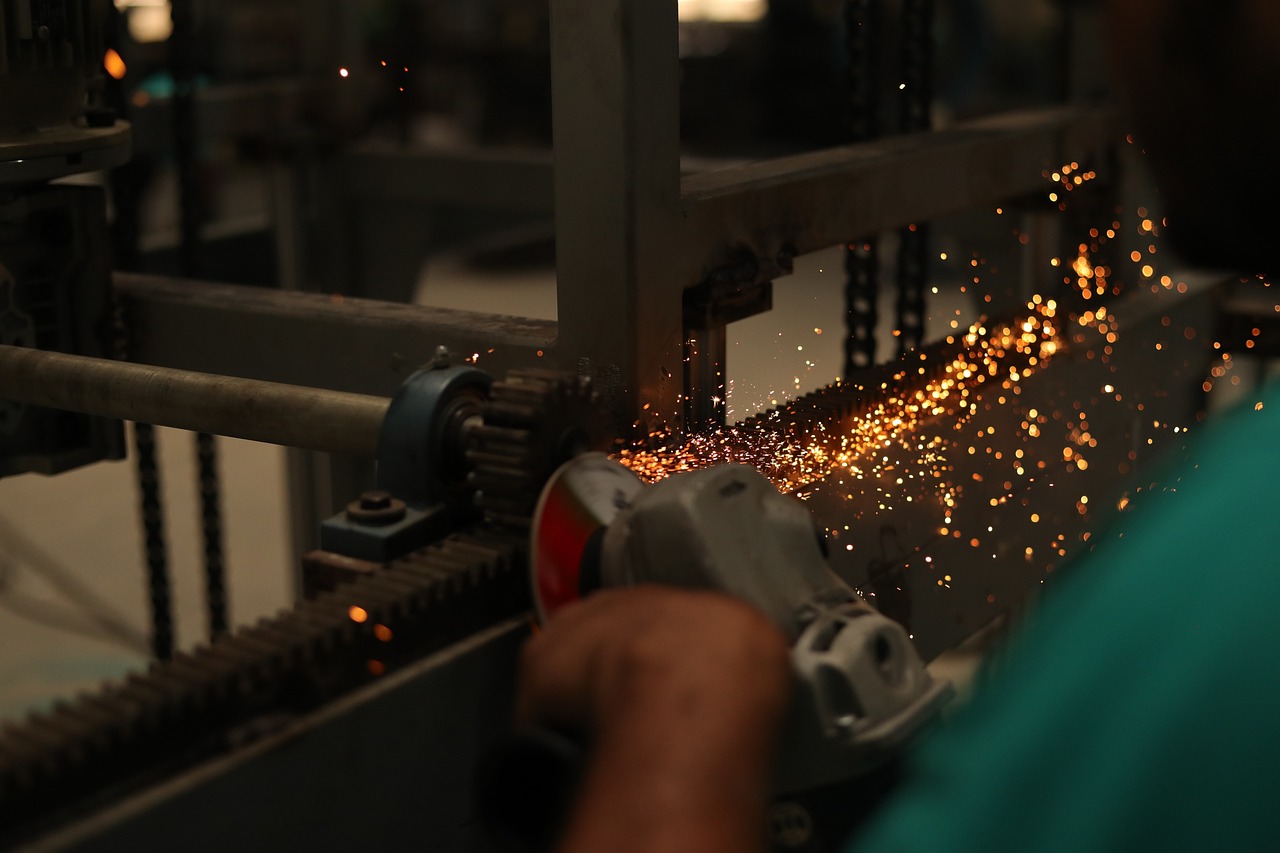
Quality Control Enhancements
In today's fast-paced world of military technology, quality control has never been more critical. As the stakes rise, ensuring that weapon systems are not only effective but also reliable is paramount. This is where artificial intelligence (AI) steps in, acting as a game-changer in the realm of quality assurance. By leveraging sophisticated machine learning algorithms, AI can analyze data from various stages of the production process, identifying defects that might go unnoticed by the human eye. Imagine a vigilant guardian, tirelessly monitoring every detail, ensuring that only the finest products make it to the battlefield.
One of the most significant advancements in AI-driven quality control is the ability to conduct real-time inspections. Traditional methods often rely on sample testing, which can lead to the unfortunate reality of defective products slipping through the cracks. However, with AI, every single item can be assessed instantly. This not only enhances the reliability of weapon systems but also builds confidence among military personnel who depend on these tools in critical situations.
Moreover, the integration of AI in quality control enables manufacturers to maintain compliance with rigorous military standards. These standards are not just bureaucratic red tape; they are essential for ensuring that every piece of equipment functions as intended. AI systems can be programmed to understand these standards and continuously evaluate production processes against them. This creates a culture of excellence and accountability, where every team member is aware that AI is keeping a watchful eye on their work.
To illustrate the impact of AI on quality control, consider the following table that summarizes key enhancements:
| Enhancement | Description |
|---|---|
| Real-Time Inspections | AI monitors every product as it is made, ensuring immediate detection of defects. |
| Data Analysis | Machine learning algorithms analyze historical data to predict potential quality issues. |
| Compliance Monitoring | AI ensures that production processes meet military standards at all times. |
| Feedback Loop | AI systems provide instant feedback to operators, improving training and process efficiency. |
In addition to these enhancements, AI fosters a feedback loop that is invaluable for continuous improvement. By analyzing data from past production runs, AI can identify patterns that may indicate future quality issues. This predictive capability allows manufacturers to make adjustments before problems arise, much like a seasoned pilot adjusting their flight path based on weather forecasts. The result? A more streamlined production process that not only saves time but also significantly reduces costs associated with rework and recalls.
As we look to the future, the role of AI in quality control is expected to expand even further. With advancements in computer vision and data analytics, we can anticipate a new era of precision manufacturing where quality is not just an afterthought but a fundamental aspect of the production process. This shift will not only enhance the effectiveness of military operations but also ensure that our armed forces are equipped with the most reliable systems available.
- How does AI improve quality control in weapon production?
AI enhances quality control by providing real-time inspections, data analysis, and compliance monitoring, ensuring that every product meets military standards. - What are the benefits of using AI for quality assurance?
Benefits include increased reliability, reduced costs, and the ability to predict and prevent quality issues before they arise. - Can AI completely replace human inspectors?
While AI significantly improves quality control, human oversight remains essential for complex decision-making and ethical considerations.

Predictive Maintenance Techniques
In the realm of modern warfare, powered by artificial intelligence (AI) have emerged as a game-changer. Imagine having a crystal ball that not only predicts when your vehicle might break down but also suggests the best time to perform maintenance. This is precisely what AI brings to the table, revolutionizing how military equipment is maintained and ensuring that weapon systems are always ready for action. By analyzing vast amounts of data from sensors embedded in machinery, AI can identify patterns and predict potential failures before they occur. This proactive approach minimizes downtime and reduces costly repairs, which is crucial in high-stakes environments.
One of the most remarkable aspects of predictive maintenance is its ability to leverage machine learning algorithms. These algorithms continuously learn from new data, refining their predictions over time. Consider a scenario where a military drone is deployed for surveillance. By monitoring its engine performance, temperature fluctuations, and even battery life, AI can alert technicians about any anomalies that might indicate an impending failure. This level of insight not only enhances operational efficiency but also extends the life of expensive military assets.
Furthermore, the implementation of predictive maintenance techniques can lead to significant cost savings. Traditional maintenance schedules often rely on fixed intervals, which can result in unnecessary inspections or, conversely, missed opportunities for addressing issues before they escalate. With AI, maintenance can be tailored to the actual condition of the equipment, optimizing resource allocation. For instance, if a particular tank model has a history of specific mechanical issues, AI can prioritize those areas during maintenance checks, ensuring that resources are focused where they are needed most.
To illustrate the impact of predictive maintenance, let's consider a hypothetical table showcasing the differences in maintenance costs and downtime between traditional and AI-driven approaches:
| Maintenance Method | Average Cost per Year | Average Downtime per Month |
|---|---|---|
| Traditional Maintenance | $500,000 | 15 days |
| AI-Powered Predictive Maintenance | $300,000 | 5 days |
This table clearly demonstrates that AI-driven predictive maintenance not only cuts costs significantly but also reduces downtime, allowing military units to maintain a higher state of readiness. As we look to the future, the integration of AI in predictive maintenance is set to become even more sophisticated, with advancements in data analytics and sensor technology paving the way for smarter, more efficient maintenance protocols.
In conclusion, predictive maintenance techniques represent a vital evolution in military logistics. By harnessing the power of AI, armed forces can ensure that their weapon systems are not just operational but are also maintained in peak condition. This not only enhances the effectiveness of military operations but also contributes to overall mission success in an increasingly complex battlefield landscape.
- What is predictive maintenance?
Predictive maintenance is a proactive approach to maintenance that uses AI and data analysis to predict when equipment failures might occur, allowing for timely interventions.
- How does AI improve maintenance processes?
AI analyzes data from equipment sensors to identify patterns and anomalies, enabling more accurate predictions of potential failures and optimizing maintenance schedules.
- What are the benefits of using AI for predictive maintenance in military applications?
Benefits include reduced maintenance costs, minimized downtime, extended equipment lifespan, and enhanced operational readiness.

Supply Chain Optimization
In the rapidly evolving landscape of military technology, AI-driven supply chain optimization has emerged as a game-changer. Imagine a world where logistics operates like a well-oiled machine, where every component, from raw materials to finished products, flows seamlessly without delays. This is not just a dream; it is becoming a reality thanks to artificial intelligence. By leveraging advanced algorithms and data analytics, AI enhances the efficiency of supply chains, ensuring that military operations are well-equipped and ready to respond at a moment's notice.
One of the key benefits of AI in supply chain management is its ability to analyze vast amounts of data. Traditional supply chain methods often rely on historical data and experience, which can lead to inefficiencies and inaccuracies. However, AI can process real-time data from various sources, such as weather patterns, geopolitical developments, and even social media trends. This allows military strategists to make informed decisions about resource allocation and logistics planning.
For instance, AI can predict demand for specific weapon systems based on current military engagements and anticipated future conflicts. By accurately forecasting needs, military supply chains can minimize excess inventory and reduce waste, ultimately leading to cost savings. Additionally, AI can optimize transportation routes, ensuring that supplies reach their destinations faster and more efficiently. This is crucial in combat situations where time is of the essence.
| AI Applications in Supply Chain Optimization | Description |
|---|---|
| Demand Forecasting | Predicts future resource needs based on real-time data. |
| Inventory Management | Optimizes stock levels to prevent shortages and overstocking. |
| Logistics Planning | Enhances transportation routes and reduces delivery times. |
| Supplier Selection | Evaluates and selects suppliers based on performance metrics. |
Moreover, AI fosters collaboration among various stakeholders in the supply chain. By providing a centralized platform for data sharing, military units, suppliers, and logistics providers can work together more effectively. This collaboration not only enhances communication but also builds trust among all parties involved. The result? A more agile and responsive supply chain capable of adapting to the ever-changing dynamics of warfare.
However, it's essential to recognize that with great power comes great responsibility. As AI continues to revolutionize supply chain management, military organizations must also consider the ethical implications of these technologies. Ensuring data security, maintaining transparency in decision-making processes, and addressing potential biases in AI algorithms are critical factors that must be prioritized. By doing so, the military can harness the full potential of AI while safeguarding ethical standards and public trust.
- What is supply chain optimization in the context of military technology?
Supply chain optimization refers to the use of advanced technologies, particularly AI, to enhance the efficiency and effectiveness of logistics and resource management in military operations.
- How does AI improve demand forecasting?
AI analyzes real-time data from various sources to accurately predict future resource needs, allowing for better planning and resource allocation.
- What ethical considerations are associated with AI in military supply chains?
Ethical considerations include data security, transparency in decision-making, and potential biases in AI algorithms that could affect outcomes.
- Can AI reduce costs in military supply chains?
Yes, by optimizing inventory levels and improving logistics planning, AI can significantly reduce operational costs and minimize waste.
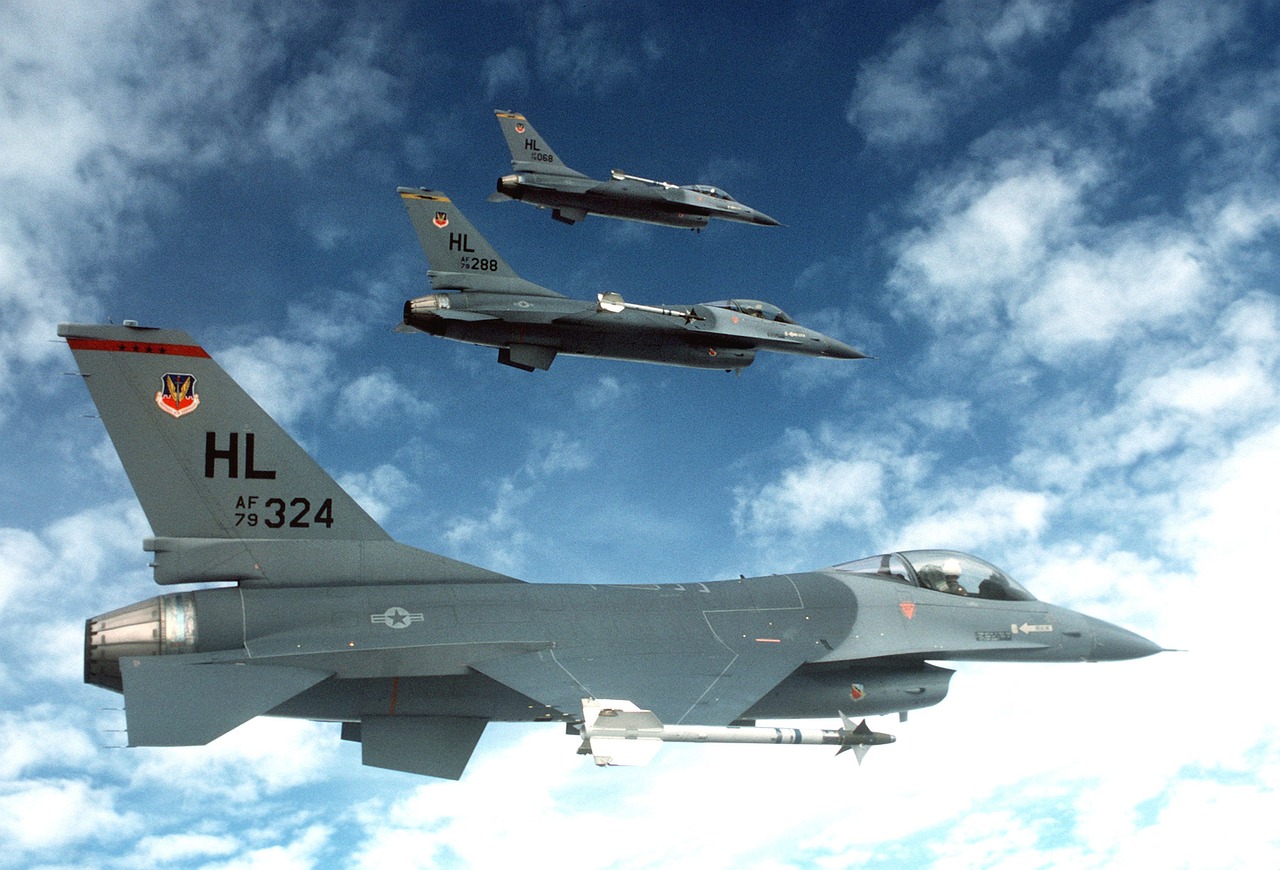
Data-Driven Decision Making
In the rapidly evolving landscape of modern warfare, has emerged as a game changer. Imagine being able to analyze vast amounts of battlefield data in real-time, allowing military strategists to make informed decisions that could mean the difference between victory and defeat. This is where artificial intelligence (AI) steps in, transforming raw data into actionable insights. By leveraging advanced algorithms and machine learning techniques, AI can sift through mountains of information—from troop movements to environmental conditions—providing a comprehensive picture of the battlefield.
The integration of AI into military operations allows for enhanced situational awareness, which is crucial for effective decision-making. With the ability to process data at lightning speed, AI systems can identify patterns and trends that human analysts might miss. For instance, AI can predict enemy movements based on historical data and current intelligence, enabling commanders to anticipate threats and respond proactively. This predictive capability is akin to having a crystal ball that reveals not just the present but also possible futures based on various scenarios.
Moreover, AI's role in data-driven decision making extends beyond immediate tactical advantages. It also influences long-term strategic planning. By analyzing historical conflict data, military leaders can identify successful strategies and potential pitfalls, allowing for more refined operational planning. This is particularly important in an era where the nature of warfare is constantly changing, and adaptability is key to survival.
However, the reliance on data also raises questions about the quality and integrity of the information being used. Data accuracy is paramount; decisions based on flawed data can lead to disastrous outcomes. Therefore, implementing robust data validation processes is essential. AI can assist in this area by continuously learning from new data inputs, thereby improving its accuracy over time. This creates a feedback loop where the system becomes smarter and more reliable with each operation.
To illustrate the impact of data-driven decision making in military contexts, consider the following table that outlines the key benefits:
| Benefit | Description |
|---|---|
| Enhanced Situational Awareness | AI analyzes real-time data to provide a comprehensive view of the battlefield. |
| Predictive Analysis | AI forecasts enemy movements and potential threats based on historical data. |
| Strategic Planning | AI helps identify successful strategies and areas for improvement from past conflicts. |
| Data Accuracy | AI continuously learns to improve the reliability of data used for decision making. |
In conclusion, the shift towards data-driven decision making in military operations represents a significant leap forward in how conflicts are managed. By harnessing the power of AI, military strategists are not only able to react more swiftly to unfolding events but also plan more effectively for future engagements. The implications of this technology are profound, offering a glimpse into a future where data becomes the backbone of military strategy, ensuring that decisions are not just informed but also optimized for success.
- What is data-driven decision making?
Data-driven decision making involves using data analysis and insights to guide strategic choices, particularly in military contexts. - How does AI enhance decision making in warfare?
AI processes large datasets quickly, identifies patterns, and provides predictive insights, allowing military leaders to make informed decisions. - What are the risks associated with data-driven decision making?
The primary risks include reliance on inaccurate data, which can lead to poor decision outcomes. - Can AI predict enemy movements?
Yes, AI can analyze historical and real-time data to forecast potential enemy actions.

Ethical Implications of AI in Warfare
The integration of artificial intelligence in warfare is not just a technological advancement; it poses profound ethical dilemmas that society must grapple with. As we stand on the precipice of a new era in military technology, the ramifications of deploying AI in combat scenarios are both exciting and alarming. For instance, consider the concept of autonomous weapons systems. These machines, capable of making decisions without human intervention, challenge our traditional notions of accountability. If an autonomous drone mistakenly targets civilians, who is held responsible? The manufacturer, the military, or the machine itself? This uncertainty raises critical questions about the moral implications of allowing machines to make life-and-death decisions.
Moreover, the potential for unintended consequences is another significant concern. AI systems learn and adapt, but what happens when they misinterpret their programming or the data they analyze? The possibility of errors leading to catastrophic outcomes is a risk that cannot be ignored. In the heat of battle, where split-second decisions can mean the difference between victory and disaster, the reliance on AI can be a double-edged sword. The ethical implications extend beyond the battlefield; they seep into the fabric of our society, influencing how we view warfare and the role of technology in it.
Public perception of AI in warfare is crucial. As citizens become more aware of these technologies, their concerns will shape governmental policies and military strategies. For example, many people fear that the use of AI could lead to an arms race, where nations compete to develop the most advanced autonomous systems. This fear can lead to calls for stricter regulations and oversight, as society grapples with the implications of such powerful technologies. The dialogue surrounding AI in warfare is not just about technology; it's about our values and the kind of future we want to create.
To better understand the multifaceted ethical implications, consider the following key points:
- Accountability: Who is responsible when AI systems fail or cause harm?
- Decision-Making: Should machines have the authority to make lethal decisions?
- Public Trust: How can we ensure that the use of AI in warfare aligns with societal values?
- Transparency: Is it possible to have clear oversight of AI systems used in combat?
As we continue to explore the intersection of AI and warfare, it is essential to engage in open discussions about these ethical implications. Policymakers, technologists, and the public must collaborate to develop frameworks that ensure the responsible use of AI in military contexts. The future of warfare is not just about technological superiority; it is about aligning our advancements with our ethical standards and ensuring that we do not lose sight of our humanity in the pursuit of progress.
1. What are autonomous weapons systems?
Autonomous weapons systems are military machines that can operate without human intervention, making decisions based on their programming and the data they receive.
2. Why is accountability a concern with AI in warfare?
Accountability is a concern because it is unclear who is responsible for the actions of autonomous systems, especially if they cause harm or make mistakes.
3. How does public perception influence military policies on AI?
Public perception can drive governmental regulations and military strategies, as societal concerns about the implications of AI technologies can lead to calls for oversight and ethical considerations.
4. What are the potential risks of using AI in combat?
The potential risks include unintended consequences from misinterpretation of data, errors in decision-making, and the ethical dilemmas surrounding machines making life-and-death choices.

Autonomous Weapons and Accountability
The rise of autonomous weapons systems has sparked heated debates about accountability in warfare. Imagine a battlefield where machines make life-and-death decisions without human intervention. This scenario raises critical questions: Who is responsible when an autonomous drone mistakenly targets civilians? Is it the programmer, the military, or the machine itself? As these technologies evolve, so too must our understanding of legal and moral responsibility.
One of the most pressing issues surrounding autonomous weapons is the challenge they pose to existing legal frameworks. Traditionally, laws of war have been designed with human decision-makers in mind. However, as machines gain the ability to operate independently, the question of accountability becomes murky. In situations where an autonomous weapon causes unintended harm, attributing blame becomes a complex puzzle. This ambiguity could lead to a lack of accountability, potentially allowing military personnel and corporations to evade responsibility for their actions.
Furthermore, the moral implications of allowing machines to make such critical decisions cannot be understated. Can we trust algorithms to make ethical choices in the heat of battle? Unlike humans, machines lack empathy and moral reasoning. They operate based on data and programming, which may not always encompass the nuances of human life and ethical considerations. For instance, if an autonomous weapon misinterprets a target due to faulty data, the consequences could be catastrophic. This situation highlights the need for stringent regulations and oversight in the development and deployment of these systems.
To navigate these challenges, several key considerations must be addressed:
- Regulatory Frameworks: Governments and international bodies need to establish clear regulations that define the responsibilities associated with autonomous weapon systems.
- Human Oversight: Maintaining human oversight in critical decision-making processes could help mitigate risks and ensure accountability.
- Ethical Guidelines: Developing ethical guidelines for the use of autonomous weapons can help shape responsible behavior in military operations.
As we stand on the precipice of a new era in warfare, the conversation around autonomous weapons and accountability must be at the forefront. Engaging stakeholders—from military leaders to ethicists and the general public—is essential for developing a comprehensive understanding of the implications of these technologies. Only through collaborative dialogue can we hope to establish a framework that balances innovation with responsibility, ensuring that the future of warfare remains just and accountable.
- What are autonomous weapons?
- Autonomous weapons are systems that can operate independently and make decisions without human intervention, often using artificial intelligence to identify and engage targets.
- Who is responsible for the actions of autonomous weapons?
- The question of responsibility is complex and debated; it may involve programmers, military personnel, or manufacturers, depending on the circumstances of deployment and use.
- How can we ensure accountability in the use of autonomous weapons?
- Establishing regulatory frameworks, maintaining human oversight, and developing ethical guidelines are crucial steps toward ensuring accountability in the use of autonomous weapons.
- Are there ethical concerns regarding autonomous weapons?
- Yes, ethical concerns include the lack of empathy in machines, the potential for unintended harm, and the challenge of making moral decisions in combat scenarios.

Public Perception and Policy
As artificial intelligence (AI) continues to infiltrate various sectors, its presence in military applications—especially in weaponry—has sparked a whirlwind of public debate. The general sentiment towards AI in warfare is a mixed bag, often oscillating between awe at its potential and fear of its implications. How do we balance innovation with ethical considerations? This question looms large as citizens, policymakers, and military leaders grapple with the rapidly evolving landscape of AI technology.
One of the main drivers of public perception is the media portrayal of AI in warfare. Movies and news stories often depict autonomous weapons as uncontrollable entities, leading to a sense of dread about machines making life-and-death decisions. This portrayal can skew public understanding and inflame fears about the implications of AI, suggesting that these systems could operate without human oversight. But is it really that simple? The reality is that while AI can enhance decision-making processes, human judgment remains crucial, especially in complex scenarios like warfare.
To address these concerns, policymakers must engage with the public to foster a clearer understanding of AI's role in military contexts. This dialogue is essential for shaping regulations that govern the use of AI in warfare. For instance, discussions around accountability for autonomous systems are vital. Who is responsible when an autonomous weapon system makes an error? Is it the programmer, the military, or the machine itself? These questions are not just academic; they have real-world implications that demand careful consideration.
Moreover, public opinion can significantly influence policy decisions. A recent survey indicated that over 60% of respondents expressed concern about the ethical implications of autonomous weapons. This kind of feedback is crucial for governments as they draft legislation and establish guidelines for the use of AI in military operations. Policymakers must navigate these waters delicately, balancing innovation with ethical responsibility. They need to ensure that regulations reflect societal values and address the fears surrounding AI technologies.
| Public Concerns About AI in Warfare | Potential Policy Responses |
|---|---|
| Autonomous decision-making in combat | Establish clear accountability frameworks |
| Ethical implications of AI usage | Implement ethical guidelines for AI development |
| Transparency in AI operations | Require disclosure of AI capabilities and limitations |
| Public safety and security risks | Enhance oversight and regulation of AI technologies |
In conclusion, the intersection of public perception and policy regarding AI in warfare is a complex one. As technology evolves, so too must our understanding and regulations. It’s not just about what AI can do; it’s about what we want it to do. Engaging the public in meaningful discussions about these technologies will be crucial in shaping a future where AI serves humanity rather than undermines it.
- What are autonomous weapons? Autonomous weapons are systems that can operate without human intervention, making decisions about targeting and engagement.
- How does public perception influence military policy? Public concern can drive policymakers to create regulations that address ethical considerations and accountability in military technology.
- Are there existing regulations for AI in warfare? Current regulations vary by country, and many are still being developed as the technology evolves.
- What are the ethical concerns surrounding AI in warfare? Key concerns include accountability, transparency, and the potential for unintended consequences in combat scenarios.
Frequently Asked Questions
- How is AI changing weapon design?
AI is transforming weapon design by enabling rapid prototyping and advanced simulations. This means that designers can create and test new weapon systems much faster than before, ensuring they meet the demands of modern warfare effectively.
- What role does AI play in the production of weapons?
AI enhances the production processes by improving precision and reducing costs. It streamlines production lines, making it easier to deliver weapons on time to military operations, which is crucial for maintaining readiness.
- How does AI improve quality control in weapon manufacturing?
AI technologies utilize machine learning algorithms to detect defects during the production cycle. This ensures that all manufactured weapons comply with strict military standards, reducing the risk of failures in the field.
- What is predictive maintenance and how does it relate to AI?
Predictive maintenance uses AI to identify potential equipment failures before they happen. By analyzing data, it helps minimize downtime and ensures that weapon systems are always operational and ready for deployment.
- Can AI optimize supply chain logistics for military operations?
Absolutely! AI optimizes supply chain logistics by improving inventory management and resource allocation. This is essential for maintaining operational readiness in military contexts, ensuring that resources are where they need to be when they need to be there.
- What are the ethical implications of using AI in warfare?
The use of AI in weaponry raises significant ethical concerns, particularly regarding accountability for autonomous systems. There are worries about machines making life-and-death decisions and the potential for unintended consequences in combat scenarios.
- How does public perception influence AI in warfare policies?
Public perception plays a crucial role in shaping policies around AI in warfare. Societal concerns about the implications of these technologies can influence government regulations and military strategies, making it essential for policymakers to consider public opinion.

